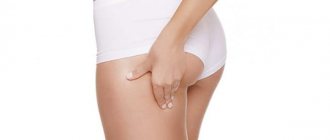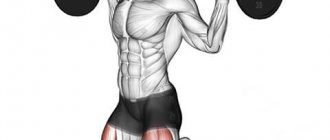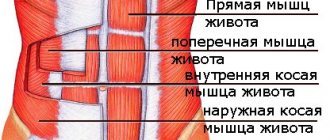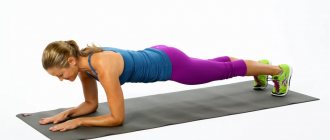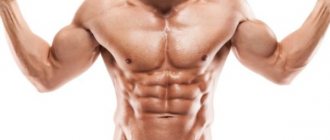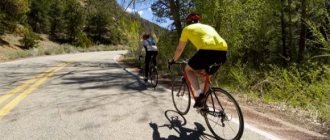Why are squats without weight so popular?
When considering the question of whether it is possible to pump up your legs with squats without weight, it should be said first of all about the reasons for the popularity of this exercise among amateur athletes:
- the trainee does not like to exercise with additional weights and is confident that by working with his own body, he will be able to achieve his goals;
- the trainee does not have the time, money and desire to visit the gym;
- There is not enough space in the house to do any other more advanced exercises.
Hack machine squats
This, in fact, although it is a squat (and does not count for our topic), can still be used by those people who do not have problems with their knees, but have problems with the spine or back muscles (and accordingly, they excluded the classic squat because of for this).
Because here the body is fixed, the load on the spine is minimal, but the only negative is that the exercise is traumatic for the knees, especially when working with heavy weights or using the wrong technique... If you decide to try, then my recommendation to you is to be careful, work according to how you feel and don’t rush to progress load on the scales. The quieter you go, the further you'll get. Have you heard?! Here, this saying comes in handy)).
I talked about this exercise in great detail in the main article: “Squats in a hack machine.”
Leg workout
The human legs are made up of muscles that increase in size if exercised properly. It is necessary to understand that the volume of this part of the body can only be increased through regular and proper training over a long period of time. When people ask how to build toned legs, the answer is that squats are the main exercise to achieve this goal.
The human legs are made up of three main muscles: the back and front of the thighs, the adductors (the inner part) and the calves. The quadriceps (outer surface) is the largest and most prominent muscle; others help keep a person upright and move the joints. The answer to the question of whether you can get bigger legs by doing squats without weights is yes, but understand that genetics play some role and many people have naturally large legs.
The Role of Additional Weight During Squats
When considering how to pump up your legs with squats, the first thing to note is the role that additional weight plays. Both squats with and without additional weight help develop muscles. Squats without weight increase muscle strength in the legs, while squats with additional weight, in addition to increasing strength, also increase volume. Many athletes, as a rule, use weights up to 70-80% of their own body weight in their training during squats.
Training plan
How long it takes to pump up your buttocks depends on your training plan. How to compose it:
- You can create a training plan yourself. Select exercises, indicate the number of approaches per workout. Write out the entire plan for a week or several months. But to draw up a training plan, it is, of course, better to have at least basic knowledge in this area. Otherwise, you may either not get any results or cause injury to yourself.
- Use ready-made plans. There are hundreds of different plans for each level: both beginners and advanced. You can choose to suit every taste.
- Use a variety of videos. Entire courses from professional trainers have been filmed on how to perform exercises for the buttocks at home.
- Go to a professional trainer. Yes, this is not always possible, but this is one of the best options. The trainer will select exercises for your goal, adjust your nutrition, and teach you the correct technique. After working with a trainer, you can go free swimming.
About the different types of squats
No one doubts the benefits of squats without weight for men and women. The exercise is necessary to give a beautiful shape to a person’s buttocks and legs, and the type of squats determines which parts of the legs are loaded more and which are used less.
First of all, the starting position largely determines the load on the muscles. The wider your legs are from each other during squats, the more load the inner thighs receive, and the less load falls on the buttocks. The depth of the squat also plays a fundamental role; the lower the athlete sits, the more the buttocks are involved in the work.
Squats are a compound exercise. This means that in the process of performing them, various muscle groups are involved in the work, and not just the muscles of the buttocks and thighs; in fact, the entire lower part of the person’s body receives physical activity.
How to squat correctly to speed up the effect
Key components of technically correct squat execution:
- Start executing an element after preliminary setup and with full concentration on the process.
- Before the main complex, do 1-2 training movements to ensure the correct position of the limbs and torso.
- Keep your posture straight and your stomach pulled in throughout the entire process.
- The surface of the feet is tightly fixed to the floor.
- Pushing the body upward occurs due to support on the heels.
- At the moment of lowering, the pelvis is retracted as much as possible, the knees do not go beyond the toes and do not turn inward.
How quickly can you pump up your buttocks with squats?
In order for classes to be as effective as possible, you should adhere to the following scheme:
- The first block is the implementation of the most complex element of the complex. The main phase of training is best to start with squats with a barbell and kettlebell.
- The second block is to do 2-3 exercises with greater dynamics, but less load: with narrow foot placement, on one leg.
- The final block - movements are performed with a stretching orientation.
At the initial stage, it is not recommended to chase the number of actions performed. It is possible to achieve progress only with high-quality development of the target zone.
Starting position for traditional squats
The correct technique for an unweighted squat is to place your feet slightly wider than hip-width apart. In this case, the toes should be slightly turned outward, the arms should be extended forward in front of you, which allows you to improve the stabilization of the body during the exercise.
Subsequently, during squats, you should move your chest a little forward, bringing your shoulder blades closer together, and also engage your abdominal muscles. All this allows you to improve the dynamics of movements.
Effective exercises for the butt
There are quite a lot of exercise options for tightening and increasing the size of your buttocks. The main thing is to choose those that are right for you. The most effective ones are: glute bridge, squats, leg presses and swings, as well as lunges.
Gluteal Bridge
The gluteal bridge works the gluteal muscles well, while eliminating unnecessary tension on the quadriceps. Number of sets: 3×15-20 repetitions.
The correct bridge technique includes the following sequence of actions:
- lie on your back, bend your knees, place your arms along your body;
- as you exhale, lift your pelvis up to a straight line between your body and hips;
- at the peak, tense your buttock muscles as much as possible and hold for 1-2 seconds;
- As we inhale, we lower ourselves, but without stopping at the lowest point, we lift the pelvis up again.
Squats
Squats work and strengthen the hamstrings, triggering processes that help build muscle.
There are many types of this exercise, but the technique is approximately the same for all:
- stand straight, feet shoulder-width apart or slightly wider;
- the chest is straightened, the toes are turned slightly to the sides;
- back straight, arched at the waist, arms in front of you;
- slowly squat so that your thighs are just below parallel to the floor.
- as you exhale, we return to the starting position, but not to the very end, and repeat the exercise.
The number of repetitions is: on the first day, 5 sets of 8-10. Every day the number of repetitions in approaches increases by 2.
Squats are not recommended for use if you have problems with the spine.
Swing your legs
Swings are aimed at working the thigh, gluteal and middle muscles. The result depends on the type of exercise chosen. Back swings are best for pumping up your butt. Number of approaches: 3×10, per leg.
Technique:
- standing on straight legs, we rest our hands on the support;
- make sure that your lower back does not bend during the exercise;
- We move our legs back one by one, as far as you can, while pulling the toe toward you;
- then return the leg to the starting position.
Leg press
The leg press is performed using a special platform, the angle of which is set individually. It is recommended to perform the first approaches without weight to practice the technique.
The leg press technique is as follows:
- We lie down on the machine so that our back is completely pressed.
- We place our feet firmly on the platform.
- We lift the platform up with our feet and remove the safety handles.
- As you inhale, smoothly lower the platform down. All weight is transferred to the heels. You need to stay in this phase for no more than 3 seconds.
- Watch your knees, they should not diverge to the sides.
- The lower back should always be pressed against the platform.
- As you exhale, press the platform up as much as possible.
To achieve results, it is recommended to perform the exercise in 3 sets of 15-20 repetitions.
Lunges
Lunges are aimed at strengthening and tightening the gluteal muscles and legs in general.
When performing lunges, it is important:
- look straight ahead;
- keep your back straight;
- do not touch the floor with your knee;
- Place your back foot on your toes, not on your full foot.
Technique for performing each exercise option:
Forward lunges:
- the body is always in an upright position, the back is straight, the gaze is directed forward;
- legs together, feet parallel to each other;
- the leg is thrown forward, widely and amplitude, while the back leg is extended, resting on the toe;
- the load is transferred more to the working leg;
- we sit down smoothly, after which we smoothly return to the starting position;
- We monitor balance;
- change the leg and do the same.
Back lunges: the starting position is the same as for classic lunges. Only the working leg remains in place, and the step is taken back with the other leg.
As you lunge, feel your gluteal muscles working.
Number of approaches: 3×10.
Mechanics of movement during squats
You should start the exercise slowly, bending your knees and lowering yourself as if you were sitting on a chair. The head and shoulders should be in a straight line along with the knees and ankles. In this case, the body weight should be distributed evenly over the surface of the entire foot. You should lower yourself until your hips are slightly below your knees. As you lower, it is recommended to raise your arms up to improve balance and stabilize the movements being performed. When an athlete performs squats without weight, his back and chest should remain straight at all times and should not be pushed forward.
As soon as the body is lowered, you should also slowly rise and return to the starting position.
How many squats should you do to quickly pump up your buttocks?
Without sports experience, it is not recommended to immediately begin intensive training. A competent training program involves gradually increasing the load and alternating the number of movements performed.
Approximate combination of squats for a month
| Approach 1 | Approach 2 | Approach 3 | Approach 4 | |
| 1 Week | 12 | 10 | 10 | 8 |
| 2 week | 15 | 15 | 12 | 10 |
| 3 week | 20 | 15 | 10 | 8 |
| 4 week | 15 | 12 | 8 | 6 |
The first days the squat is performed without weights. Starting from the second week, weight is added - 1-2.5 kg. If the exercise is performed too easily, more massive weights are used.
Non-traditional types of squats without weight
The positive effect of squats without weight on the leg muscles can be increased if you practice not only traditional squats, but also their other types. The following are the most common non-traditional types of exercise:
- With support on the wall: in this type of squats, you need to take the starting position exactly the same as in the case of regular squats, only this time your hips will rest against the wall. After lowering your hips to knee level, you need to stay in this position for 10 seconds and then return to the starting position.
- Narrow squats: Place your feet together and extend your arms forward to maintain balance. Lower your body until your thighs are parallel to the floor, then lift your body and return to the starting position.
- Back Squats: The starting position for this exercise is exactly the same as for the narrow squats. At the final stage of the exercise, when the legs are almost straightened, it is necessary to throw the right leg back, while straining the buttocks. During the next squat, do the same with your left leg.
- Sumo squats: They are performed with the legs wide apart, the toes of the feet pointing outward, and the hands placed together on the chest. When performing squats, your back should be straight.
How long does it take to pump up a girl’s buttocks?
A beautiful and fit figure is a lot of work. To achieve good results, you need not only to adjust your diet, but also to exercise regularly.
Many girls are interested in how long it takes to pump up their buttocks and how to choose the right exercises.
There are many different methods that give good results, but experts recommend creating training taking into account your own preferences and capabilities.
No matter how much you would like to achieve what you want in a week, this is unrealistic. Experts assure that everything depends solely on the person, that is, on his desire and willpower. Regularity is important in training, otherwise you may not expect results.
You shouldn't exercise every day, as the muscles need to recover and rest.
Understanding the topic of how long it takes to pump up your buttocks, it is worth pointing out the opinions of professional trainers who say that if you exercise at least three days a week, you can notice the first results within a month.
- "Bridge"
. Lie on your back and bend your knees. As you inhale, lift your torso up while squeezing your buttocks. To add load, you can bring your knees together during this. Number of repetitions – 20 times. - "Toe-heel"
. Place your feet wider than your shoulders and point your toes outward. Place your hands on your hips. Bend your legs at the knees so that they form a right angle. Slowly rise and fall on your toes. Number of repetitions – 12 times. - "Rocket"
. Place your feet shoulder-width apart. When performing a deep squat, extend your arms forward, bend your body forward, and take one leg back. As a result, the body should form a straight line. Stay in this position for a few seconds. Repeat on the other leg. The number of repetitions is 12 times on each leg.
Another hot topic is how long it takes to pump up your buttocks with squats, since this is the simplest and most common exercise among both men and women.
To this question, trainers answer that to achieve minimal results you will have to train for at least two months.
It is important to perform the exercise correctly: you need to squat slowly and lower yourself until a right angle is formed in your knees
Another rule is that your knees should not go beyond your toes.
Benefits of Squats Without Weight
The answer to the question of whether it is possible to pump up your legs with squats without weight has already been given above. Now let's look in more detail at the question of what benefits there are from performing this exercise. Many fitness trainers recommend including squats in your workouts. Is there any benefit to doing squats without weight? The answers are in the list below:
- Squats allow you to train the endurance of the leg muscles, and can also serve as a warm-up for the muscles before performing exercises that require greater muscle effort and energy consumption. These exercises involve a large number of muscle groups, which allows you to quickly increase your body temperature, preparing it for the training process.
- Squats are effective for burning excess calories. It is also important that this exercise is quite simple, so it can be performed as part of more complex complexes. In addition, they can be performed by people with different levels of physical fitness.
- You can do squats without weight every day because they only require a small amount of space and there is no need for any additional equipment.
- Exercise helps train the cardiovascular system and accelerates metabolism in the body.
- The benefits of squats without weight are undeniable, but when an athlete has already mastered the technique of performing them to a perfect degree, additional weights should be added. It is recommended to start working with weights under the guidance of a trainer, since additional load if used incorrectly can lead to serious injuries.
Benefits and Disadvantages of Squats Without Weight for Men and Women
Benefits of air squats:
- Prepares muscles for deep squats with weights.
- Strengthens stabilizer muscles, which are responsible for maintaining the correct position of the joints.
- Give an understanding of the technique of performing squats with weights.
- The exercise can be included in all kinds of circuit training and CrossFit complexes aimed at increasing endurance and losing weight.
- Accelerates metabolism due to the speed of execution and the involvement of most muscles of the body.
- Does not injure joints and does not put pressure on intervertebral discs.
Disadvantages of the exercise:
- It does not allow you to increase muscle volume, since it does not involve working with weights necessary for these purposes.
- Jerking and not following safety precautions can injure joints and ligaments.
- Does not improve strength.
How many squats per day is recommended?
It is not easy to answer this question, since the specific number of squats depends on a number of factors: the physical condition of the student, age, his weight and the goal that he has set for himself.
If we talk about beginner athletes, then they should start with high-repetition squats without weight. However, first you need to master the correct technique for performing them. In the first week of training, it is recommended to perform 4-5 series of 10 squats. Thus, a novice athlete will perform 40-50 squats a day, and training should be done every other day so that the leg muscles have time to rest and recover.
Subsequently, you can either increase the number of squats or start using additional weights. You will soon notice that the muscles in your legs have become stronger, and your legs themselves look more beautiful and toned.
How long does it take to pump up your buttocks at home with squats?
Many athletes ask how long it takes to pump up their buttocks at home with squats, what needs to be done for this, and whether there are other exercises besides squats to pump up their buttocks. After all, there are sets of exercises, tips and tricks to pump up beautiful buttocks. The main thing is to put them into practice and you will achieve results.
In the article you will learn how and for how long you can pump up your buttocks at home with squats and other exercises, as there is a whole range of recommendations, tips and exercises for the buttocks
Proper nutrition and playing other sports are also important. Find out: how to properly pump up your buttocks at home and in the gym
How long does it take to pump up your buttocks?
The first thing you need to pump up your buttocks is to set a clear and correct goal that can quickly help you achieve the desired result. Imagine in your mind an image of yourself already with pumped up buttocks, or find a photo of the buttocks that you want to pump up. Attach this goal in a visible place.
Also, in order to be able to pump up your buttocks at home with squats, you need to put a date for implementation next to your signature next to the goal. This will incredibly speed up the process and you will achieve your goal even ahead of schedule. Find out: how to squat to pump up your butt.
How long does it take to pump up your buttocks with exercises?
To pump up your buttocks with exercises, you first need to create a training plan that will allow you to get closer to your goal. Just write down on a piece of paper point by point the exercises you need to do, sets and repetitions, time and schedule.
To understand how long it takes to pump up your buttocks at home with squats, you need to remember that you don’t need to rush and do heavy loads at first. It will be enough to train 3 times a week, without missing classes, and then the result will be. Find out: how to quickly pump up the buttocks of a girl and a man in the gym.
How long does it take to pump up your buttocks - recommendations
If you don’t know how long it will take to pump up your buttocks at home with squats, then remember, it all depends on you, your desire and regular training. Basically, 2-3 weeks are enough for your buttocks to begin to show at least some changes. But for the best results, it is better to practice for at least 2-3 months.
To be able to pump up your buttocks at home with squats or other exercises, you need to take care of proper nutrition. Try to eat 3 times at the same time every day. Don't overeat, eat healthy foods with more vitamins and proteins. Drink 2-3 liters of clean water per day.
SportSovety.ruSports tips in pictures and videos
Mistakes when performing squats
Despite the fact that squats without weight are a fairly simple exercise that even a beginner can do, there are still errors in execution that can lead to damage to certain parts of the athlete’s body. Let's look at them:
- First of all, squats should be done slowly and not go too low, since you can damage the ligaments in the knee joints. Shallow squats, in turn, strengthen the knees and increase the strength of the quadriceps and thigh muscles.
- It is not recommended to perform the exercise too quickly. The fact is that when lowering quickly, the body acquires great acceleration, and then it is difficult to lift it, due to its inertial properties. Fast squats significantly increase the load on the knee joints, which significantly increases the risk of injury. In addition, performing the exercise quickly causes imbalance and makes it difficult for the athlete to maintain proper technique.
- Not only the knees, but also the lumbar area experiences stress when performing squats. A common mistake athletes make is bending the body in the abdominal area during an exercise. This occurs when the hips rise faster than the shoulders and the upper body leans forward. This incorrect technique can lead to injuries in the lumbar region, such as a slipped disc.
- Raising your heels during squats is a mistake. This happens due to limited mobility in the hips and ankles. If a beginner makes this mistake, it is recommended to place a thin plate under the heels to make them higher. This measure helps to master the correct technique, but should not be abused. It is also recommended to develop the joints in the ankles and hips, increasing the range of motion.
Why exclude squats altogether?
For many reasons, for example, injuries to the back muscles, spine, injured knee joints, chronic hemorrhoids, etc. In general, to be honest, squats are not the most beneficial exercise for joints (but one of the most effective), especially when working with heavy weights, which can “erase” the cartilaginous surfaces of the joints and lead to pain and inflammation.
I also know those guys who have big butts, and when they squat, it increases even more (even despite the correct technique required), so they said goodbye to the squat)), I also know those who are afraid for their narrow waist, which when working with heavy weights it will inevitably increase.
Okay, that’s not really the point of the topic. They excluded it, which means there is a reason for it. Because it’s unlikely that anyone will simply exclude one of the most effective exercises out of the blue))).
What are the alternatives, what to do, what exercise to do, how to pump your legs?!



